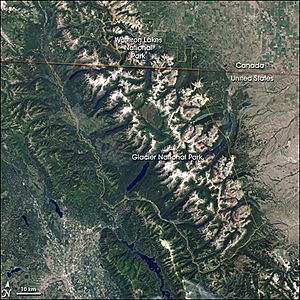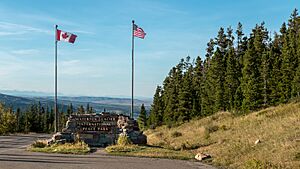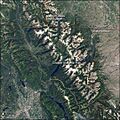Waterton-Glacier International Peace Park facts for kids
Quick facts for kids Waterton Glacier International Peace Park |
|
|---|---|

Landsat 7 image of Waterton-Glacier International Peace Park
|
|
| Location | Alberta, Canada and Montana, United States |
| Formed | June 18, 1932 |
| Governing body | Parks Canada, U.S. National Park Service |
| Lua error in Module:Location_map at line 420: attempt to index field 'wikibase' (a nil value). | |
| UNESCO World Heritage Site | |
| Includes | Waterton Lakes National Park Glacier National Park |
| Criteria | Natural: (vii), (ix) |
| Inscription | 1995 (19th Session) |
| Area | 457,614 ha (1,766.86 sq mi) |
The Waterton-Glacier International Peace Park is a special place where two national parks meet at the border between Canada and the United States. It combines Waterton Lakes National Park in Canada with Glacier National Park in the U.S. Both parks are recognized by UNESCO as Biosphere Reserves, which means they are important areas for both nature and people. Together, they form a World Heritage Site, celebrating their unique natural beauty and the idea of peace between countries.
Contents
A Special Park's Story
How the Peace Park Began
The idea for the Waterton-Glacier International Peace Park came from many people over time. In the late 1800s and early 1900s, some people dreamed of a park without borders. These early supporters included George "Kootenay" Brown, a Canadian forest ranger, and Albert Henry Reynolds, an American ranger.
The Rotary Clubs from Cardston, Alberta in Canada and Montana in the U.S. played a big part. They held a meeting in 1931 and decided to ask their governments to create the Peace Park. A Canadian politician, John Smith Stewart, and an American politician, Scott Leavitt, worked together to make this happen.
The U.S. government passed a law to create the park in December 1931. Canada's government followed, and the law was approved in May 1932. This made the Waterton-Glacier International Peace Park official.
The park was formally dedicated on June 18, 1932. A ceremony for the Canadian side was held later in July 1936. This was because of the Great Depression, a tough economic time. At this ceremony, a stone monument called a cairn was dedicated to Kootenay Brown, who loved conservation.
Park Updates Over Time
Even though they are one Peace Park, the two parks are managed separately. This means you pay different fees to enter each side.
In 2007, the International Dark-Sky Association named Waterton-Glacier International Peace Park an International Dark-Sky Park. This means it's a great place to see the stars at night because there's very little light pollution.

Crossing the Border
The Chief Mountain Border Crossing is the only road that lets you drive between the Canadian and U.S. parts of the Peace Park. You can reach it using Montana Highway 17 from the U.S. side and Alberta Highway 6 from the Canadian side. This border crossing is special because it closes during the winter months.
Images for kids
See also
 In Spanish: Parque internacional de la Paz Waterton-Glacier para niños
In Spanish: Parque internacional de la Paz Waterton-Glacier para niños



